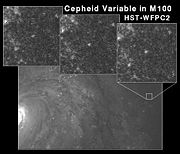- Cepheid
-
Die Cepheiden sind eine Gruppe der veränderlichen Sterne mit sehr regelmäßiger Pulsation. Sie haben besondere Bedeutung für die Astrophysik, weil sie als Indikator für die Leuchtkraft und damit für die Sternentfernungen dienen. Sie sind Riesensterne und teilen sich in mehrere verwandte Gruppen.
Inhaltsverzeichnis
Beschreibung
Die klassischen oder Delta-Cepheiden sind die bedeutendste Unterklasse der pulsationsveränderlichen Sterne. Ihren Namen erhielten sie nach dem Stern δ Cephei im Sternbild Cepheus. Sie verändern ihre Leuchtkraft streng periodisch, dabei verändert sich auch ihre Oberflächentemperatur und somit ihre Spektralklasse. Typische Cepheiden pulsieren mit einer Periodendauer von einigen Tagen, δ Cephei beispielsweise mit ca. 5,37 Tagen, in denen sich seine Ausdehnung um ca. 2,7 Millionen Kilometer ändert.
Bekannte Vertreter:
- Delta Cephei (δ Cep A)
- Beta Doradus (β Dor)
- Bezek (η Aql)
- Mekbuda (ζ Gem A)
- Polarstern (α UMi A)
Physik des Pulsationsprozesses
Grundlage für die Pulsation der Cepheiden ist der Kappa-Mechanismus. Das ionisierte Gas in der Sternhülle ist für die Strahlung des Sternes nicht durchsichtig und heizt sich durch Absorption auf. Die Temperaturerhöhung hat zur Folge, dass die Absorptionsfähigkeit sinkt und Druck und Temperatur wieder abnehmen. Der Stern zieht sich aufgrund seiner eigenen Gravitation wieder zusammen.
Entfernungsmessung
Delta-Cephei-Sterne werden oft auch als Entfernungsmarkierungssterne bezeichnet, da Astronomen sie als Standardkerzen zur Entfernungsbestimmung von Galaxien benutzen. [1]
Dabei wird zum einen ausgenutzt, dass Cepheiden als Riesensterne sehr helle Objekte sind. Man kann sie von der Erde aus bis zu einer Entfernung von einigen Megaparsec, mit dem Hubble-Weltraumteleskop bis zu etwa 20 Megaparsec, d. h. auch noch in benachbarten Galaxien, beobachten. Zum anderen stellte Henrietta Swan Leavitt 1912 fest, dass die absolute Helligkeit (M) bzw. Leuchtkraft eines Cepheiden fest mit dem Logarithmus der Pulsationsperiode (P in Tagen) zusammenhängt. Diese sogenannte Perioden-Leuchtkraft-Beziehung lautet[2]:
- M = − 2,902log(P) − 1,203
Damit ist es möglich, aus der Beobachtung des Lichtwechsels eines Cepheiden auf seine absolute Helligkeit zu schließen.
Aus dem Unterschied zwischen der absoluten Helligkeit (M) und der messbaren scheinbaren Helligkeit (m) kann man dann mit Hilfe der Distanzgleichung seine Entfernung (D in Parsec) herleiten:
- D = 10(m − M + 5) / 5.
Siehe auch
Einzelnachweise
- ↑ Star Observer: Special Nr. 9, 2002, S. 102 u. 103
- ↑ David Dunlap Observatory – Database Of Galactic Classical Cepheids.David Dunlap Observatory, University of Toronto, 1995.
Literatur
- Gerhard Mühlbauer: Cepheiden: Meilensteine im Universum. In: Sterne und Weltraum – Astronomie in der Schule. Nr. 10, 2003 (PDF).
Wikimedia Foundation.

